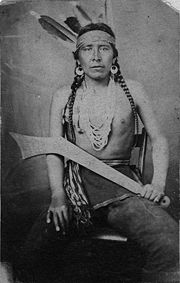
Big Eagle
Encyclopedia

Mdewakanton
Mdewakantonwan are one of the sub-tribes of the Isanti Dakota . Their historic home is Mille Lacs Lake in central Minnesota, which in the Dakota language was called mde wakan .As part of the Santee Sioux, their ancestors had migrated from the Southeast of the present-day United States, where the...
Dakota Sioux in Minnesota. In 1862 he and his band joined Taoyateduta
Taoyateduta
Little Crow was a chief of the Mdewakanton Dakota Sioux. His given name translates as "His Red Nation," but he was known as Little Crow because of his father's name, Čhetáŋ Wakhúwa Máni, which was mistranslated.Little Crow is notable in for his role in the...
and took part in a Sioux
Sioux
The Sioux are Native American and First Nations people in North America. The term can refer to any ethnic group within the Great Sioux Nation or any of the nation's many language dialects...
uprising. He eventually surrendered.
Early life
Waŋbdí Tháŋka, also known as Jerome Big Eagle, was born in 1827 at Black Dog village, in present-day EaganEagan, Minnesota
Eagan is a city south of Saint Paul in Dakota County in the U.S. state of Minnesota. The city lies on the south bank of the Minnesota River, upstream from the confluence with the Mississippi River. Eagan and nearby suburbs form the southern portion of Minneapolis-St. Paul, the fifteenth largest...
, Minnesota
Minnesota
Minnesota is a U.S. state located in the Midwestern United States. The twelfth largest state of the U.S., it is the twenty-first most populous, with 5.3 million residents. Minnesota was carved out of the eastern half of the Minnesota Territory and admitted to the Union as the thirty-second state...
. His succeeded his father, Máza Ȟóta (Grey Iron) in 1857. He along with the other chiefs and headmen went to Washington in 1858 on treaty business. In the spring of 1862, Wamditanka, Little Crow and Traveling Hail were candidates for Speaker of the Mdewakanton tribe which Traveling Hail won.
Big Eagle lead his band at the second battles of New Ulm and Fort Ridgley and also Birch Coulee and Wood Lake.
The photograph of Big Eagle was taken in Davenport during the summer of 1864.
W. W. Hathaway, then the assistant commissary at Camp Kearney (the Indian Stockade, at Camp McClellen, Davenport) described the circumstances of making the File:
"I was also a personal friend of Big Eagle, the chief of the tribe confined in the pen. An amusing incident arose during the summer when I tried to get a photograph of the old chief. There was a mulatto named Jack confined with the Indians and he conspired with me to get the old brave to sit for a picture. Accordingly Big Eagle put on all his finery and paraphernalia and we went down to the studio of a photographer who had opened up his place of business down on the river road at the end of what is still known as “Hog’s Back Ridge.” Everything went well until we neared the place when Big Eagle began to remove his finery. We asked him what the trouble was and he said he would not pose unless we paid him $15"
(Davenport Weekly Democrat, September 28, 1905).
Despite his death sentence, and his tribal importance, President Lincoln pardoned Big Eagle in November 1864 and he was ordered released on December 3 The History of Carroll County, Illinois... (H. F. Kett & Co., Chicago, n.d.), p. 80.

